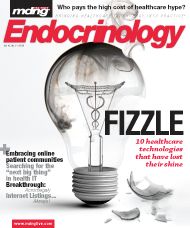The Next Big Thing: New technological breakthroughs impacting the field of endocrinology
Data interpretation and management has become increasingly more challenging and time consuming.
The incidence of type 2 diabetes is increasing globally at an alarming rate. Over the last seven years, there has been a 54% increase in newly diagnosed cases according to the CDC. More than 35% of adults have diabetes or impaired glucose tolerance, and 3,500 new cases of type 2 diabetes are diagnosed in the US daily. There are fewer endocrinology specialists than needed for the current patient demand, and the numbers of those entering practice are dwindling. Furthermore, the proliferation of technology to measure blood glucose values, including relatively inexpensive glucometers and continuous glucose monitors, have added data overload to the mix. This data comes at the physician from many diff erent portals, including the Internet, FAX, e-mail, and telephone calls.
Historically, reimbursement codes for cognitive services relating to the treatment of diabetes have been poorly compensated in a world of procedure-oriented compensation. What makes matters worse is that time spent providing services has gone up but the codes have not kept pace with these developments. For example, the codes do not make allowances for data interpretation
from devices that were not yet available when the codes were established.
Data interpretation and management has become increasingly more challenging and time consuming. Much, if not all, of this information—although ostensibly meant to help the patient and the physician reach goals—adds to the amount of time physicians spend on patients without compensation. My upcoming column in MDNG will review some of the technological advances
in diabetes care and emphasize the need for data management.
An article in the New York Times on June19, 2008 citing the New England Journal of Medicine reported that only 20% of physicians use electronic medical records. Most physicians lack the fi nancial incentive to invest in computerized records that could assist in data management. To help address this, Medicare announced a $150 million incentive plan to help physicians make the transition. Major increases in acceptance of insulin pump therapy, more frequent self-monitoring of blood glucose values, and continuous glucose monitoring have revolutionized the care of people with diabetes but have also created new challenges.
Insulin pump settings
There are five insulin pumps available for commercial use in the US. All have basal and bolus rates, insulin-to-carbohydrate ratios, and insulin sensitivity factors. Basal and bolus ratios can be set to multiple rates at diff erent times of day, as can the insulin-to-carbohydrate and insulin sensitivity factors. For example, a child may have a pattern for weekdays and weekends and may have diff erent ratios and factors for breakfast and for dinner. Th e healthcare team must look at those settings within the context of blood glucose readings, food intake, and exercise and make changes in those settings if necessary. Software programs do exist that allow for download of these settings, which are helpful, yet each program is diff erent than the other and thus has unique outputs.
Glucometer readings
The availability of small and aff ordable glucometers coupled with an increased physician emphasis on more frequent testing has led to patients testing more frequently. Downloadable software exists for many meters, and there is a lack of standardization of how the data is analyzed across the many platforms.
Continuous glucose sensors
There are three FDA-approved devices for continuous glucose monitoring. Th ese devices measure and report blood sugars moment to moment, allowing healthcare providers and patients alike to look at the patterns of blood sugars. With more than 200 readings per day for 3-7 days at a time, they present a challenge to interpret.
Because the myriad of devices have their own proprietary software, the output from those devices are unique. Th erefore, the healthcare team must learn the specifi c way that each software program delivers the output. Innovations in the fi eld of data analysis around blood glucose values continue to provide better solutions for the management of data. For example, the Cerner Corporation has created a Web-based software solution to provide standardized output, regardless of whether patients are using multiple meters, even if they are diff erent brands. By creating one electronic log-book, the healthcare team can quickly glance through the data and make suggestions for improvement in care. This author logs onto the Web and looks at the electronic log-book together with the patient and family. This is but one tool that tries to standardize output from diff erent platforms. A new development in data management that may be signifi cant for people with diabetes is the offering by Google and Microsoft of consumercontrolled PHRs that are stored in servers hosted by those companies. These personal health records may be integrated into the EMR, thus providing software solutions for communication between physician and patient. Ultimately a combination of software solutions that provide insight tools to the patient and healthcare provider, as well as increase reimbursement for provision of service currently not reimbursed, will be necessary to off set the time required for data management to help patients reach American Association of Clinical Endocrinologists and American Diabetes Association goals for blood glucose levels.
Henry Anhalt, DO, FAAP, FACOP, FACE, CDE, is Physician Editor-in-Chief of MDNG: Endocrinology Edition.
